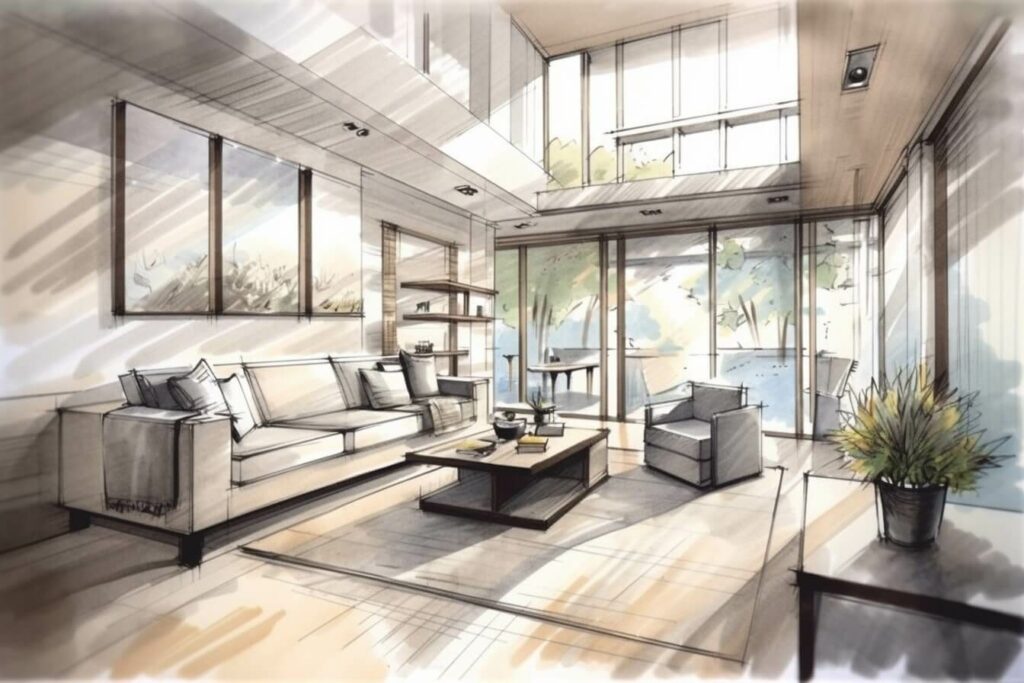




A 2-day immersion into the future of sustainable construction
Crossed ventilation is an essential concept in architecture and interior design that involves using natural air currents to create comfortable and healthy indoor environments.
In this article, we will explore the benefits of crossed airing, the factors that influence it, and some of the most frequently asked questions about this design strategy.
What is Crossed Ventilation?
Crossed airing is a natural ventilation strategy that uses the movement of air currents to improve indoor air quality and thermal comfort. The idea behind this concept is to create openings on opposite walls of a building or room, allowing fresh air circulation.
The air movement created by these openings creates a natural cooling effect, reducing the need for mechanical cooling systems.
Crossed ventilation is achieved by placing openings, such as windows or vents, on opposite walls or sides of a building. The airflow created by these openings creates a continuous flow of fresh air throughout the building, providing a natural cooling effect in warm climates and improving indoor air quality.


Benefits of Crossed Ventilation
Crossed ventilation offers several benefits, making it an attractive option for architects and interior designers looking to improve the comfort and sustainability of their buildings. Here are some of the main benefits of crossed airing:
- Improved Indoor Air Quality: Crossed airing allows fresh air circulation throughout a building, reducing the buildup of indoor air pollutants and improving indoor air quality.
- Energy Efficiency: Crossed airing reduces the need for mechanical cooling systems, which can significantly reduce energy consumption and greenhouse gas emissions.
- Comfort: Crossed ventilation creates a natural cooling effect, significantly improving thermal comfort in warm climates.
- Cost-Effective: Crossed airing is a cost-effective solution that can reduce operational costs and maintenance expenses compared to mechanical cooling systems.








A 2-day immersion into the future of sustainable construction
Factors that Influence Crossed Ventilation
Several factors can influence the effectiveness of crossed airing in a building or room. Here are some of the main factors that architects and interior designers should consider when implementing crossed ventilation strategies:
- Building Orientation: The orientation of a building can significantly impact the effectiveness of crossed airing. Buildings that are oriented perpendicular to prevailing winds can benefit the most from crossed airing.
- Building Shape: The shape of a building can also influence the effectiveness of crossed airing. Buildings with rectangular or square shapes are more suitable for crossed ventilation than buildings with irregular shapes.
- Window Placement: Wearing windows and vents is crucial for effective crossed airing. Windows and vents should be placed on opposite walls or sides of a building or room to allow fresh air circulation.
- Climate: The climate of a region can also impact the effectiveness of crossed airing. Crossed ventilation is most effective in regions with warm or temperate climates.
Frequently Asked Questions About Cross Ventilation
How does crossed ventilation work?
Crossed airing creates openings on opposite walls or sides of a building or room, allowing for fresh air circulation. The movement of air currents creates a natural cooling effect, reducing the need for mechanical cooling systems.
What are the benefits of crossed ventilation?
Crossed airing offers several benefits, including improved indoor air quality, energy efficiency, comfort, and cost-effectiveness.
What factors influence crossed ventilation?
Several factors, including building orientation, shape, window placement, and climate can influence the effectiveness of crossed airing.
Can crossed ventilation be used in all types of buildings?
Crossed airing can be used in most types of buildings, but it is most effective in buildings with a rectangular or square shape that are oriented perpendicular to prevailing winds.
Can crossed ventilation be used in all climates?
Crossed airing is most effective in warm or temperate climates. Still, it can improve indoor air quality and reduce the need for mechanical cooling systems.


Crossed Ventilation: A Conclusion
Crossed ventilation is an effective and sustainable way to improve indoor air quality and thermal comfort in buildings. By using natural air currents, architects and interior designers can create healthy and comfortable indoor environments that are energy-efficient and cost-effective.
At UGREEN, we specialize in sustainability consultancy services for professionals and companies. We understand the importance of sustainable design and can provide expert advice on incorporating crossed ventilation and other sustainable design strategies into your projects.
We also offer UGREEN Skills, our sustainability educational platform for professionals and companies. UGREEN Skills provides comprehensive training on sustainable design, including energy efficiency, renewable energy, and sustainable materials. By investing in sustainability education, professionals and companies can gain a competitive edge and contribute to a more sustainable future.
In conclusion, crossed ventilation is a simple yet effective design strategy that can significantly improve the sustainability and comfort of buildings. By working with UGREEN, architects and interior designers can access expert advice and education on sustainable design, helping to create a more sustainable future for us all.








A 2-day immersion into the future of sustainable construction
If you need our services in the Portuguese language, click here.

